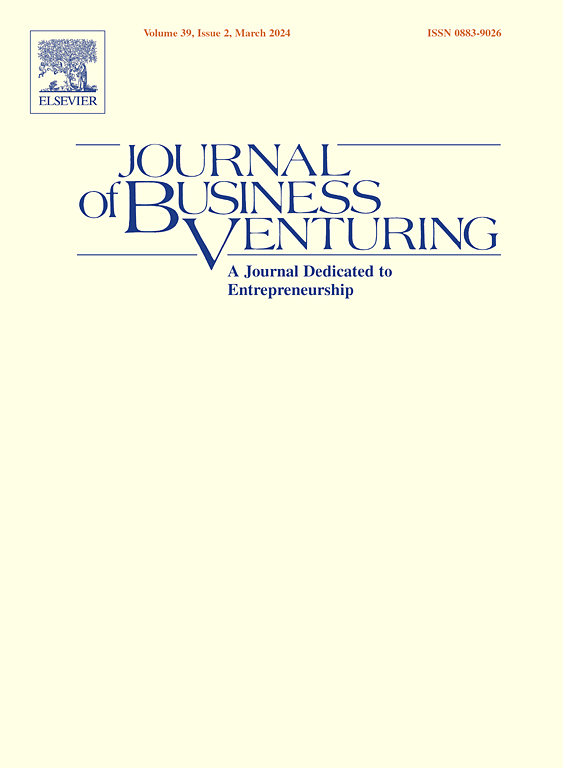Waves and rips: Abalone, entrepreneurial variants, and community functioning
IF 8.9
1区 管理学
Q1 BUSINESS
引用次数: 0
Abstract
While the entrepreneurship literature has explored distinct types of opportunities, such as sustainable, unsustainable, social, and commercial, the diverse and integrated processes through which each type of opportunity is exploited remain poorly understood. Indeed, prior research tends to conceptualize opportunity exploitation as uniform and binary, such as sustainable or unsustainable, rather than as a set of dynamic processes and activities shaped by local contexts. Through an inductive study of the South African abalone industry, we explore entrepreneurial variants—differentiated processes and activities of opportunity exploitation—offering a framework for identifying and interpreting the integrated mechanisms through which opportunities are exploited within a local system. We found that the community members perceive that these entrepreneurial variants generate two primary dynamics: pernicious dynamics (i.e., processes that community members believe diminish the functioning of the community) and symbiotic dynamics (i.e., processes that community members believe enhance the functioning of the community). We shed light on how a local system comprises multiple entrepreneurial variants, each embodying distinct relationships with and implications for the local ecology, people, and place. We also offer insights into when mostly unsustainable entrepreneurship can involve symbiotic dynamics and when mostly sustainable entrepreneurship can involve pernicious dynamics. We conclude by discussing the implications for both entrepreneurship theory and practice.
Executive summary
Opportunity exploitation is a core element of entrepreneurship. Scholars have recently begun investigating unsustainable entrepreneurship, where entrepreneurs exploit opportunities in ways that cause harm to the natural environment. Scholars have also examined sustainable entrepreneurship, where entrepreneurs exploit opportunities that generate solutions to diminish the harm caused to the natural environment. Indeed, much of the existing entrepreneurship literature has relied on binary constructions, such as the exploitation of sustainable or unsustainable opportunities or of social or commercial opportunities. These constructions largely focus on singular underlying processes and outcomes of opportunity exploitation, offering limited insights into how opportunity exploitation may involve multiple, overlapping, or even conflicting processes and activities within a local system.
Thus, while prior research has often conceptualized opportunity exploitation in static and binary terms, a deeper understanding of the dynamic, context-dependent processes and activities through which opportunities are exploited remains elusive. In particular, we lack a structured framework to examine the underlying interconnected processes and activities of opportunity exploitation. Advancing such a framework would allow scholars and practitioners to move beyond reductive classifications of ‘beneficial’ or ‘harmful’ and toward a more nuanced, systemic understanding of entrepreneurship as it unfolds within specific local contexts. Therefore, in this study, we inductively explore how changes in a local system give rise to distinct entrepreneurial variants—differentiated processes and activities of opportunity exploitation. We also explore how these entrepreneurial variants interrelate and affect the functioning of the local community in which they are embedded.
Our exploration of the South African abalone industry reveals that the entrepreneurs in this industry pursue different entrepreneurial variants following a regulatory event, leading to markedly different outcomes. We found that these entrepreneurial variants result in both the depletion and preservation of resources while hindering or supporting the functioning of the local community in which they are embedded. We found two primary dynamics at play within this system: pernicious dynamics (i.e., processes that community members believe diminish the functioning of the community) and symbiotic dynamics (i.e., processes that community members believe enhance the functioning of the community). We also found when mostly unsustainable entrepreneurship can involve symbiotic dynamics and when mostly sustainable entrepreneurship can involve pernicious dynamics.
Our study makes several important contributions to the entrepreneurship literature. First, we shed light on entrepreneurial variants, providing a framework for explaining the interrelated processes and activities through which opportunities are exploited within a local system. Second, we contribute to theories of opportunities by offering insight into the markedly distinct processes and activities underlying opportunity exploitation, emphasizing how these unfold through the interactions of entrepreneurs embedded within a local system. Third, we extend theories of sustainability by exploring entrepreneurs who exploit opportunities that mostly harm the natural environment, entrepreneurs who exploit opportunities that mostly generate sustainable alternatives to preserve the natural environment, and the richness of the relationship between them in impacting a local community's functioning.
波浪与激流:鲍鱼、创业变体和社区功能
第三,我们扩展了可持续性理论,探讨了企业家利用的机会大多损害自然环境,企业家利用的机会大多产生可持续的替代方案,以保护自然环境,以及他们之间的丰富关系,在影响当地社区的功能。
本文章由计算机程序翻译,如有差异,请以英文原文为准。
求助全文
约1分钟内获得全文
求助全文
来源期刊

Journal of Business Venturing
BUSINESS-
CiteScore
16.70
自引率
6.90%
发文量
59
审稿时长
77 days
期刊介绍:
The Journal of Business Venturing: Entrepreneurship, Entrepreneurial Finance, Innovation and Regional Development serves as a scholarly platform for the exchange of valuable insights, theories, narratives, and interpretations related to entrepreneurship and its implications.
With a focus on enriching the understanding of entrepreneurship in its various manifestations, the journal seeks to publish papers that (1) draw from the experiences of entrepreneurs, innovators, and their ecosystem; and (2) tackle issues relevant to scholars, educators, facilitators, and practitioners involved in entrepreneurship.
Embracing diversity in approach, methodology, and disciplinary perspective, the journal encourages contributions that contribute to the advancement of knowledge in entrepreneurship and its associated domains.
 求助内容:
求助内容: 应助结果提醒方式:
应助结果提醒方式:


